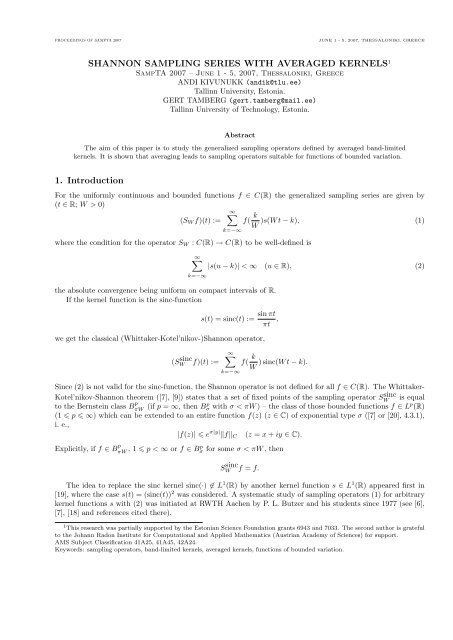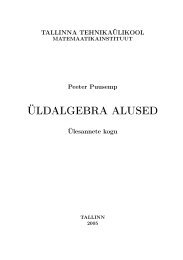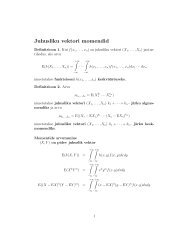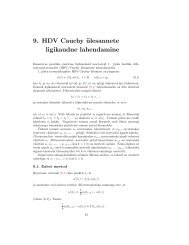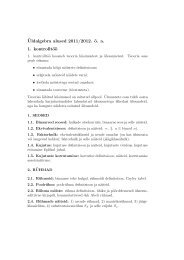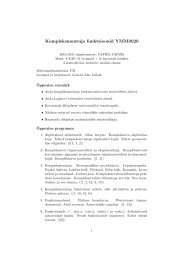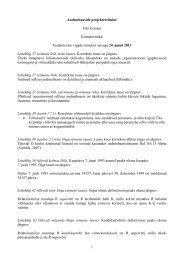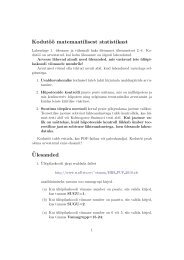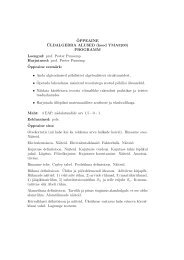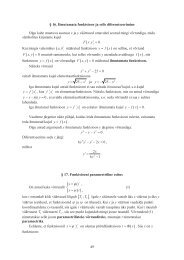SHANNON SAMPLING SERIES WITH AVERAGED KERNELS1 1 ...
SHANNON SAMPLING SERIES WITH AVERAGED KERNELS1 1 ...
SHANNON SAMPLING SERIES WITH AVERAGED KERNELS1 1 ...
You also want an ePaper? Increase the reach of your titles
YUMPU automatically turns print PDFs into web optimized ePapers that Google loves.
PROCEEDINGS OF SAMPTA 2007 JUNE 1 - 5, 2007, THESSALONIKI, GREECE<br />
<strong>SHANNON</strong> <strong>SAMPLING</strong> <strong>SERIES</strong> <strong>WITH</strong> <strong>AVERAGED</strong> KERNELS 1<br />
SampTA 2007 – June 1 - 5, 2007, Thessaloniki, Greece<br />
ANDI KIVUNUKK (andik@tlu.ee)<br />
Tallinn University, Estonia.<br />
GERT TAMBERG (gert.tamberg@mail.ee)<br />
Tallinn University of Technology, Estonia.<br />
Abstract<br />
The aim of this paper is to study the generalized sampling operators defined by averaged band-limited<br />
kernels. It is shown that averaging leads to sampling operators suitable for functions of bounded variation.<br />
1. Introduction<br />
For the uniformly continuous and bounded functions f ∈ C(R) the generalized sampling series are given by<br />
(t ∈ R; W > 0)<br />
∞<br />
(SW f)(t) := f( k<br />
)s(W t − k), (1)<br />
W<br />
k=−∞<br />
where the condition for the operator SW : C(R) → C(R) to be well-defined is<br />
∞<br />
k=−∞<br />
the absolute convergence being uniform on compact intervals of R.<br />
If the kernel function is the sinc-function<br />
|s(u − k)| < ∞ (u ∈ R), (2)<br />
s(t) = sinc(t) :=<br />
we get the classical (Whittaker-Kotel’nikov-)Shannon operator,<br />
(S sinc<br />
W f)(t) :=<br />
∞<br />
k=−∞<br />
sin πt<br />
,<br />
πt<br />
f( k<br />
) sinc(W t − k).<br />
W<br />
Since (2) is not valid for the sinc-function, the Shannon operator is not defined for all f ∈ C(R). The Whittaker-<br />
Kotel’nikov-Shannon theorem ([7], [9]) states that a set of fixed points of the sampling operator Ssinc W is equal<br />
to the Bernstein class B p<br />
πW (if p = ∞, then Bp σ with σ < πW ) – the class of those bounded functions f ∈ Lp (R)<br />
(1 p ∞) which can be extended to an entire function f(z) (z ∈ C) of exponential type σ ([7] or [20], 4.3.1),<br />
i. e.,<br />
|f(z)| e σ|y| fC (z = x + iy ∈ C).<br />
Explicitly, if f ∈ B p<br />
πW , 1 p < ∞ or f ∈ Bp σ for some σ < πW , then<br />
S sinc<br />
W f = f.<br />
The idea to replace the sinc kernel sinc(·) ∈ L 1 (R) by another kernel function s ∈ L 1 (R) appeared first in<br />
[19], where the case s(t) = (sinc(t)) 2 was considered. A systematic study of sampling operators (1) for arbitrary<br />
kernel functions s with (2) was initiated at RWTH Aachen by P. L. Butzer and his students since 1977 (see [6],<br />
[7], [18] and references cited there).<br />
1 This research was partially supported by the Estonian Science Foundation grants 6943 and 7033. The second author is grateful<br />
to the Johann Radon Institute for Computational and Applied Mathematics (Austrian Academy of Sciences) for support.<br />
AMS Subject Classification 41A25, 41A45, 42A24.<br />
Keywords: sampling operators, band-limited kernels, averaged kernels, functions of bounded variation.
2 A.KIVUNUKK, G.TAMBERG<br />
In this paper we study an even band-limited kernel s, i.e. s ∈ B 1 π, defined by an even window function<br />
λ ∈ C [−1,1], λ(0) = 1, λ(u) = 0 (|u| 1) by the equality<br />
s(t) := s(λ; t) :=<br />
In fact, this kernel is the Fourier transform of λ ∈ L 1 (R),<br />
s(t) =<br />
1<br />
0<br />
λ(u) cos(πtu) du. (3)<br />
π<br />
2 λ∧ (πt). (4)<br />
These types of kernels arise in conjunction with window functions widely used in applications (e.g. [1], [2], [8],<br />
[16]), in Signal Analysis in particular. Many kernels can be defined by (3), e.g.<br />
1) λ(u) = 1 defines the sinc function;<br />
2) λ(u) = 1 − u defines the Fejér kernel sF (t) = 1 2 t<br />
2sinc 2 (cf. [19]);<br />
3) λj(u) := cos π(j + 1/2)u, j = 0, 1, 2, . . . defines the Rogosinski-type kernel (see [11]) in the form<br />
2 πu<br />
4) λH(u) := cos 2<br />
rj(t) := 1<br />
<br />
2<br />
sinc(t + j + 1<br />
1<br />
) + sinc(t − j −<br />
2 2 )<br />
<br />
= (−1)j<br />
π<br />
1 = 2 (1 + cos πu) defines the Hann kernel (see [13])<br />
(j + 1/2) cos πt<br />
(j + 1/2) 2 ; (5)<br />
− t2 sH(t) := 1 sinc t<br />
; (6)<br />
2 1 − t2 5) λB,a(u) := 1<br />
1<br />
2 + a cos πu + ( 2 − a) cos 3πu defines the Blackman-Harris kernel (a special case of the general<br />
cosine window, where: a0 = 1<br />
2 , a1 = a = 1<br />
2 − a3, a2 = 0, cf. [14], [15])<br />
sB,a(t) := (16a − 9)t2 + 9<br />
2(1 − t 2 )(9 − t 2 )<br />
sinc t = 1<br />
2<br />
3<br />
k=0<br />
ak<br />
<br />
<br />
sinc(t + k) + sinc(t − k) . (7)<br />
If a = 9/16 the latter has especially rapid decrease at infinity – s B,9/16(t) = O(|t| −5 ) as |t| → ∞.<br />
First we used the band-limited kernel in general form (3) in [10], see also [5].<br />
Now we will study the sampling operators (1) using averaged kernels of the kernel functions (3), i.e.<br />
sm(t) := 1<br />
m<br />
m/2 <br />
−m/2<br />
s(t + v) dv (m > 0), (8)<br />
which is suitable for functions of bounded variation. To give concrete examples we restrict ourselves to Blackman-<br />
Harris kernels, because they are rapidly decreasing at infinity and the Blackman-Harris operators have norms,<br />
which are very close to one.<br />
We say that the sampling operator SW : T V (R) → T V (R) has the variation detracting property for functions<br />
f ∈ T V (R) of bounded variation (cf. [4] and references cited therein), if<br />
VR[SW f] SW VR[f]. (9)<br />
As an introductory approach we use averaged kernels to get for these operators the variation detracting property.<br />
2. Preliminary results<br />
The most general kernel for the sampling operators (1) is defined in the following way.
<strong>SHANNON</strong> <strong>SAMPLING</strong> <strong>SERIES</strong> <strong>WITH</strong> <strong>AVERAGED</strong> KERNELS 3<br />
Definition 1 ([18, Def. 6.3]) If s : R → C is a bounded function such that<br />
∞<br />
k=−∞<br />
the absolute convergence being uniform on compact subsets of R, and<br />
∞<br />
k=−∞<br />
then s is said to be a kernel for sampling operators (1).<br />
|s(u − k)| < ∞ (u ∈ R), (10)<br />
s(u − k) = 1 (u ∈ R), (11)<br />
The definition formulated above guarantees that operators (1) give approximations for continuous functions<br />
f ∈ C(R).<br />
Theorem 1 ([7, Th. 4.1]) Let s ∈ C(R) be a kernel. Then {SW } W >0 defines a family of bounded linear<br />
operators from C(R) into itself, satisfying<br />
SW = sup<br />
∞<br />
u∈R<br />
k=−∞<br />
|s(u − k)| (W > 0). (12)<br />
In the following we assume that our kernel (3) belongs to L1 (R), which yields s ∈ B1 π, because the Fourier<br />
transform of s,<br />
s ∧ (x) = 1<br />
<br />
x<br />
<br />
√ λ<br />
2π π<br />
implies s ∧ (x) = 0 for |x| π. (13)<br />
For the band-limited functions s ∈ B p π ⊂ L p (R) the norm (12) is related to the norm sp as shown in following.<br />
Theorem 2 (Nikolskii inequality; [17, p. 124], [9, Th. 6.8]) Let 1 p ∞. Then, for every s ∈ B p σ,<br />
sp sup<br />
u∈R<br />
∞<br />
k=−∞<br />
|s(u − k)| p<br />
1/p<br />
(1 + σ)sp.<br />
From the Nikolskii inequality we see that our assumption s ∈ L 1 (R) is sufficient for (10) and thus s in (3) is<br />
indeed a kernel in the sense of Definition 1.<br />
3. Sampling operators with averaged kernels and the variation detracting property<br />
The variation detracting property of certain sampling operators will be considered for T V (R), the space of<br />
all functions of bounded variation on R endowed with the seminorm<br />
f T V (R) := VR[f] = sup<br />
I⊂R<br />
VI[f] = sup sup<br />
I⊂R xj∈I<br />
j=1<br />
n<br />
|f(xj) − f(xj+1)|,<br />
the first supremum being taken over all intervals I ⊂ R. By AC(R) we denote the subspace of T V (R) consisting<br />
of those functions, which are locally absolutely continuous on R. We say that the sampling operator SW :<br />
T V (R) → T V (R) has the variation detracting property (see [4] and references cited therein), if (9) is valid for<br />
every f ∈ T V (R). This property is important in practice, since very often signals are discontinuous but still<br />
with bounded variation.<br />
Looking for sampling operators with the variation detracting property our first observation was that if we<br />
take λL,m(u) = sinc mu (m ∈ N) as a window function, then by (3) we obtain the averaged sinc-function<br />
sL,m(t) = 1<br />
2m<br />
m<br />
−m<br />
sinc(t + v) dv. (14)
4 A.KIVUNUKK, G.TAMBERG<br />
Here L stands for Lanczos, since sinc as the window is often called the Lanczos window [21].<br />
Although the sinc function does not belong to B 1 π, the kernel sL,m does. Indeed, integrating by parts in (14)<br />
yields for |t| > m<br />
sL,m(t) = (−1)m cos(πt)<br />
π 2 (t 2 − m 2 )<br />
and therefore sL,m ∈ L 1 (R). On the other hand, by (3)<br />
sL,m(t) =<br />
which shows by the Paley-Wiener theorem that sL,m ∈ B 1 π.<br />
Now we will average some other kernels s ∈ B 1 π.<br />
1<br />
0<br />
1<br />
−<br />
2π2m t+m <br />
t−m<br />
sinc(mu) cos(πut) du,<br />
cos(πu)<br />
u 2<br />
Theorem 3 Let the kernel s ∈ B 1 π be defined by (3) using the window function λ. Then the window function<br />
defines by (3) the averaged kernel sm ∈ B 1 π, where<br />
Proof: By (3) we have<br />
Using the representation<br />
it is possible to write (16) in the form<br />
sm(t) = 1<br />
m<br />
= 1<br />
2m<br />
= 1<br />
2m<br />
Since s ∈ L 1 (R), we have by (15)<br />
<br />
R<br />
λm(u) := λ(u) sinc mu<br />
2<br />
sm(t) = 1<br />
m<br />
sm(t) :=<br />
m/2 <br />
−m/2<br />
m/2 <br />
−m/2<br />
m/2 <br />
−m/2<br />
1<br />
0<br />
sinc mu<br />
2<br />
0<br />
m/2 <br />
−m/2<br />
λ(u) sinc mu<br />
2<br />
1<br />
=<br />
m<br />
m/2 <br />
−m/2<br />
(m > 0)<br />
du<br />
s(t + v) dv. (15)<br />
cos(πtu) du. (16)<br />
cos(πvu) dv<br />
1<br />
dv λ(u) cos(πvu) cos(πtu) du<br />
<br />
dv<br />
0<br />
1<br />
<br />
<br />
λ(u) cos π(t − v)u + cos π(t + v)u du<br />
<br />
<br />
s(t − v) + s(t + v) dv = 1<br />
m<br />
|sm(t)|dt 1<br />
m<br />
m/2 <br />
−m/2<br />
R<br />
m/2 <br />
−m/2<br />
⎛ ⎞<br />
<br />
⎝ |s(t)|dt⎠<br />
dv = s1.<br />
s(t + v) dv.<br />
Hence, by (16), sm ∈ B 1 π.<br />
To obtain the estimates for the variation detracting property we first have to estimate the operator norms.
<strong>SHANNON</strong> <strong>SAMPLING</strong> <strong>SERIES</strong> <strong>WITH</strong> <strong>AVERAGED</strong> KERNELS 5<br />
Theorem 4 Let the sampling operator SW be defined by the kernel s ∈ B 1 π from (3) and the averaged sampling<br />
operator SW,m be defined by the kernel sm ∈ B 1 π, m ∈ N, from (15). Then the operator norm of the sampling<br />
operator SW,m has an estimate<br />
SW,m s1 SW .<br />
Proof: For s ∈ B 1 π we have by the definition (15)<br />
∞<br />
k=−∞<br />
|sm(u − k)| =<br />
= 1<br />
m<br />
∞<br />
∞<br />
k=−∞<br />
which by Theorem 1 yields<br />
Using Theorem 2 we get<br />
m−1 <br />
<br />
<br />
<br />
1<br />
<br />
m<br />
<br />
m/2 <br />
−m/2<br />
<br />
−m/2+j+1<br />
k=−∞ j=0<br />
−m/2+j<br />
<br />
<br />
<br />
<br />
s(u − k + v) dv<br />
<br />
<br />
1<br />
m<br />
|s(k − v − u)| dv = 1<br />
m<br />
∞<br />
SW,m s1.<br />
m/2 <br />
k=−∞<br />
−m/2<br />
m−1 <br />
SW,m s1 SW .<br />
∞<br />
j=0 k=−∞<br />
k−1<br />
|s(u − k + v)| dv<br />
k<br />
= 1<br />
m−1 <br />
m<br />
<br />
j=0<br />
−∞<br />
|s(w + m<br />
2<br />
∞<br />
|s(v)| dv =<br />
For some averaged sampling operators we can compute the exact value of the norm.<br />
− j − u)| dw<br />
∞<br />
−∞<br />
|s(v)| dv = s1,<br />
Theorem 5 If there exists a constant a ∈ [0, 1], such that for all k ∈ Z the kernel function s ∈ B1 π does not have<br />
zeroes on (a − k − 1<br />
1<br />
2 , a − k + 2 ), then for the sampling operator SW,1 with the kernel s1 defined by (15) (m = 1)<br />
we get an exact value of the operator norm<br />
SW,1 = s1.<br />
Proof: By the definition of the operator norm<br />
SW,1 = sup<br />
∞<br />
u∈[a−1/2,a+1/2]<br />
k=−∞<br />
|s1(u − k)| <br />
∞<br />
k=−∞<br />
For s ∈ B 1 π we have by the definition (15) and by the assumption on zeroes<br />
By (17) we get<br />
∞<br />
k=−∞<br />
|s1(a − k)| =<br />
∞<br />
<br />
<br />
<br />
<br />
<br />
<br />
<br />
1/2<br />
k=−∞<br />
−1/2<br />
=<br />
∞<br />
k<br />
k=−∞<br />
k−1<br />
<br />
<br />
<br />
<br />
s(a − k + v) dv<br />
=<br />
<br />
<br />
|s(w − a + 1<br />
)| dw =<br />
2<br />
SW,1 s1.<br />
Using Theorem 4 completes the proof.<br />
Now we are able to consider the variation detracting property.<br />
∞<br />
1/2<br />
k=−∞<br />
−1/2<br />
∞<br />
−∞<br />
|s1(a − k)|. (17)<br />
|s(a − k + v)| dv<br />
|s(v)| dv = s1.<br />
Theorem 6 Let the sampling operator SW be defined by the kernel s ∈ B 1 π from (3) and the averaged sampling<br />
operator SW,m be defined by the kernel sm ∈ B 1 π , m ∈ N, from (15). Then f ∈ T V (R) implies SW,mf ∈ AC(R)<br />
and<br />
VR[SW,mf] s1 VR[f] SW VR[f], (18)<br />
moreover, under the assumptions of Theorem 5, we have<br />
VR[SW,mf] SW,1 VR[f]. (19)
6 A.KIVUNUKK, G.TAMBERG<br />
Proof: Let f ∈ T V (R), hence f is bounded on R. Since sm ∈ B 1 π, the derivative s ′ m ∈ B 1 π also, and by<br />
Nikolskii inequality <br />
k∈Z |s′ m(u − k)| < ∞. Therefore, there exists the bounded derivative<br />
(SW,mf) ′ (t) = W<br />
∞<br />
k=−∞<br />
f( k<br />
W )s′ m(W t − k),<br />
which implies SW,mf ∈ AC(R). Now we have for the total variation<br />
Since by (15) the derivative<br />
we get<br />
(SW,mf) ′ (t) = W<br />
m<br />
∞<br />
k=−∞<br />
k=−∞<br />
VR[SW,mf] =<br />
s ′ m(t) = 1<br />
<br />
m<br />
f( k<br />
W )<br />
<br />
∞<br />
−∞<br />
s(t + m<br />
2<br />
s(W t − k + m<br />
2<br />
|(SW,mf) ′ (t)|dt. (20)<br />
m<br />
) − s(t −<br />
2 )<br />
<br />
,<br />
m<br />
) − s(W t − k −<br />
2 )<br />
<br />
= W<br />
<br />
∞<br />
f(<br />
m<br />
k=−∞<br />
k<br />
∞ m<br />
)s(W t − k + ) −<br />
W 2<br />
k=−∞<br />
= W<br />
∞<br />
<br />
f(<br />
m<br />
k − m<br />
) − f(k<br />
W W )<br />
<br />
s(W t − k + m<br />
2 )<br />
= W<br />
m−1 <br />
m<br />
∞<br />
j=0 k=−∞<br />
<br />
f(<br />
k − j<br />
W<br />
Now by (20) and Theorem 4 we obtain for the total variation<br />
VR[SW,mf] 1<br />
m−1 <br />
m<br />
j=0 k=−∞<br />
∞<br />
<br />
<br />
<br />
− j − j − 1<br />
f(k ) − f(k<br />
W W<br />
)<br />
<br />
<br />
<br />
<br />
f( k<br />
m<br />
)s(W t − k −<br />
W 2 )<br />
<br />
− j − 1<br />
) − f(k<br />
W<br />
)<br />
<br />
s(W t − k + m<br />
2 ).<br />
∞<br />
−∞<br />
<br />
<br />
s(W t − k + m<br />
2 )<br />
<br />
<br />
d(W t)<br />
1<br />
m−1 <br />
VR[f]s1 = s1VR[f] SW VR[f]. (21)<br />
m<br />
j=0<br />
Under the assumptions of Theorem 5 we have s1 = SW,1, therefore<br />
VR[SW,1f] SW,1VR[f]<br />
4. Examples of operators with variation detracting property<br />
4.1 Hann’s sampling operators<br />
We can provide more examples of operators with variation detracting property (9).<br />
2 πu<br />
Take the Hann window λH(u) := cos . Then by (3)<br />
sH(t) = 1<br />
<br />
<br />
sinc(t − 1) + 2 sinc t + sinc(t + 1)<br />
4<br />
and its corresponding averaged kernel by (15) is<br />
sH,1(t) = 1<br />
<br />
4<br />
2<br />
Sci(t + 1<br />
2<br />
) − Sci(t − 1<br />
2<br />
= 1<br />
<br />
<br />
r0(t − 1/2) + r0(t + 1/2) =<br />
2<br />
sinc t<br />
3<br />
3<br />
) + Sci(t + ) − Sci(t −<br />
2 2 )<br />
<br />
,<br />
2(1 − t 2 )<br />
(22)
where the integral sinc is defined by<br />
<strong>SHANNON</strong> <strong>SAMPLING</strong> <strong>SERIES</strong> <strong>WITH</strong> <strong>AVERAGED</strong> KERNELS 7<br />
Sci(x) :=<br />
x<br />
0<br />
sinc(v)dv.<br />
Since sH does not have zeroes on (k, k + 1) for all k ∈ Z, we obtain by Theorems 5 and 6<br />
Corollary 1 Let f ∈ T V (R). Then HW,mf ∈ AC(R) and<br />
<br />
<br />
VR[HW,mf] HW,1VR[f] = Sci(1) + Sci(2) VR[f] = (1.0409 . . .)VR[f].<br />
Proof: The first inequality follows immediately from (18) of Theorem 6. We need only to compute the norm<br />
sH1. We have by (22)<br />
∞<br />
2<br />
∞<br />
sH1 = 2 |sH(t)| dt = 2 sH(t)dt + 2 (−1) k+1<br />
<br />
0<br />
2<br />
<br />
= 2 sH(t)dt − 2<br />
0<br />
0<br />
1<br />
0<br />
k=2<br />
k+1<br />
k<br />
sH(t)dt<br />
∞<br />
(−1) k sH(t + k)dt. (23)<br />
The representation of the kernel sH using Rogosinski kernels r0 in (22) allows us to write<br />
2<br />
2n<br />
k=2<br />
(−1) k sH(t + k) =<br />
So, we have by (5)<br />
<br />
2<br />
0<br />
1<br />
=<br />
2n<br />
k=2<br />
2n<br />
k=2<br />
k=2<br />
(−1) k<br />
<br />
r0(t + k − 1/2) + r0(t + k + 1/2)<br />
(−1) k r0(t + k − 1/2) −<br />
∞<br />
(−1) k sH(t + k)dt = 1<br />
2<br />
k=2<br />
1<br />
0<br />
<br />
(−1) k r0(t + k − 1/2) = r0(t + 3/2) + r0(t + 2n + 1/2).<br />
2n+1<br />
k=3<br />
<br />
<br />
sinc(t + 1) + sinc(t + 2)<br />
The representation of the kernel sH using sinc functions in (22) gives<br />
<br />
2<br />
0<br />
2<br />
sH(t)dt = 1<br />
2<br />
2<br />
0<br />
<br />
<br />
sinc(t − 1) + 2 sinc t + sinc(t + 1)<br />
dt = 1<br />
2<br />
Combining the equalities (25) and (24) we get from (23) by Theorem 5<br />
4.2 Lanczos’ sampling operators<br />
HW,1 = sH1 = Sci(1) + Sci(2).<br />
dt = 1<br />
2<br />
<br />
<br />
Sci(3) − Sci(1) . (24)<br />
<br />
<br />
Sci(1) + 2 Sci(2) + Sci(3) . (25)<br />
We can see that the Lanczos’ window function λL,m(u) = sinc(mu) for m = 2j + 1 can be represented via the<br />
Rogosinski’s window function λR,j(u) = cos π(j + 1/2)u as follows,<br />
λL,2j+1(u) = λR,j(u) sinc<br />
(2j + 1)u<br />
.<br />
2<br />
Now, by Theorem 3 (m = 2j + 1), the Lanczos’ sampling operator LW,2j+1 can be considered as the averaging<br />
of the Rogosinski sampling operator RW,j, i.e.<br />
Therefore we can use Theorem 6 getting<br />
LW,2j+1 = RW,j,2j+1.
8 A.KIVUNUKK, G.TAMBERG<br />
Corollary 2 Let the sampling operator LW,2j+1 be defined by the window function λL,2j+1(u) = sinc(2j + 1)u<br />
using (3). Then f ∈ T V (R) implies LW,2j+1f ∈ AC(R) and<br />
In particular,<br />
VR[LW,2j+1f] rj1VR[f] RW,jVR[f].<br />
VR[LW,1f] LW,1VR[f] = 2 Sci(1)VR[f] = (1.178979 . . .)VR[f].<br />
Proof: The first inequalities follow immediately from (18) of Theorem 6. For the second inequality we have<br />
consider the Rogosinski kernel (5) (j = 0)<br />
r0(t) =<br />
cos πt<br />
2π(1/4 − t 2 ) ,<br />
which does not have zeroes on (−k − 1/2, −k + 1/2). Therefore, by (19) we get VR[LW,1f] LW,1VR[f], where<br />
the numerical value of the norm LW,1 was calculated in [12], Theorem 1.<br />
Let us state an elementary proposition using the Rogosinski-type kernels.<br />
Proposition 1 For the kernel (14) we have<br />
thus d<br />
dt sL,m ∈ B 1 π.<br />
d<br />
dt sL,m(t) = 1<br />
m<br />
m<br />
j=1<br />
Proof: From the definition (14) we get<br />
<br />
r0(t − m + 2j − 1<br />
2 ) − r0(t − m + 2j − 3<br />
2 )<br />
<br />
,<br />
d<br />
dt sL,m(t) = 1<br />
(sinc(t + m) − sinc(t − m))<br />
2m<br />
= 1<br />
m<br />
(sinc(t − m + 2j) − sinc(t − m + 2(j − 1))) ,<br />
2m<br />
j=1<br />
which by (5) gives the assertion.<br />
Although sinc ∈ L 1 (R) we get in rather similar way as in Theorem 6 the following more general result for<br />
the Lanczos operators LW,m defined by the kernel (14).<br />
Theorem 7 Let f ∈ T V (R). Then for the Lanczos sampling operators LW,m defined by the kernel (14) we have<br />
LW,mf ∈ AC(R) and<br />
VR[LW,mf] LW,1VR[f],<br />
where LW,1 = r01 = 1.178979 . . .<br />
Proof: As in Theorem 6 we have<br />
where the derivative is<br />
By Proposition 1 we get<br />
(LW,mf) ′ (t) = W<br />
m<br />
= W<br />
m<br />
∞<br />
k=−∞<br />
m<br />
VR[LW,mf] =<br />
(LW,mf) ′ (t) = W<br />
f( k<br />
W )<br />
∞<br />
j=1 k=−∞<br />
<br />
f(<br />
m<br />
j=1<br />
∞<br />
−∞<br />
∞<br />
k=−∞<br />
|(LW,mf) ′ (t)|dt,<br />
f( k<br />
W )s′ L,m(W t − k).<br />
<br />
r0(W t − k − m + 2j − 1<br />
2 ) − r0(W t − k − m + 2j − 3<br />
2 )<br />
<br />
k + 2j<br />
W<br />
<br />
+ 2j − 1<br />
) − f(k ) r0(W t − m − k −<br />
W<br />
1<br />
2 ).
<strong>SHANNON</strong> <strong>SAMPLING</strong> <strong>SERIES</strong> <strong>WITH</strong> <strong>AVERAGED</strong> KERNELS 9<br />
For the total variation we obtain<br />
VR[LW,mf] = 1<br />
<br />
∞<br />
<br />
m ∞<br />
<br />
<br />
<br />
k + 2j + 2j − 1<br />
m f( ) − f(k ) r0(W t − m − k −<br />
<br />
W W<br />
−∞<br />
j=1 k=−∞<br />
1<br />
2 )<br />
<br />
<br />
<br />
<br />
d(W t)<br />
<br />
1<br />
m r01<br />
m ∞<br />
<br />
<br />
<br />
<br />
+ 2j + 2j − 1 <br />
f(k ) − f(k ) <br />
W W r01VR[f]. (26)<br />
j=1 k=−∞<br />
For the numerical value of LW,1 see Proof of Corollary 2.<br />
4.3 Blackman-Harris’ sampling operators<br />
The Blackman-Harris window λB,9/16 := 1<br />
16 (8 + 9 cos πu − cos 3πu) defines by (7) (a = 9/16) the kernel<br />
and by (15) the averaged kernel<br />
sB,9/16;1(t) = 1<br />
<br />
16<br />
7 Sci(t + 1<br />
2<br />
s B,9/16(t) :=<br />
) − 7 Sci(t − 1<br />
2<br />
9<br />
2(1 − t 2 )(9 − t 2 )<br />
3<br />
3<br />
) + 9 Sci(t + ) − 9 Sci(t −<br />
2 2 )<br />
+ Sci(t + 5<br />
2<br />
sinc t (27)<br />
) − Sci(t − 5<br />
2<br />
7<br />
7<br />
) − Sci(t + ) + Sci(t −<br />
2 2 )<br />
<br />
.<br />
Since sB,9/16 does not have zeroes on (k, k + 1) (k ∈ Z), we can compute by Theorem 5, using the scheme of the<br />
proof of Corollary 1, for the corresponding operator the norm<br />
BW,9/16;1 = sB,9/161 = 1<br />
<br />
<br />
11 Sci 1 + 15 Sci 2 + Sci 3 − 8 Sci 4 − 2 Sci 5 + Sci 6 = 1.178986 . . .<br />
8<br />
Theorem 6 applies also in this case.<br />
Corollary 3 Let f ∈ T V (R). Then B W,9/16;mf ∈ AC(R) and<br />
VR[B W,9/16;mf] B W,9/16;1VR[f] = (1.178986 . . .)VR[f].<br />
The two-parameter Blackman-Harris window, which is defined by (a0, a1 ∈ R)<br />
defines the kernel function<br />
where<br />
λ B,(a0,a1)(u) := a0 + a1 cos πu + ( 1<br />
2 − a0) cos 2πu + ( 1<br />
2 − a1) cos 3πu, (28)<br />
s B,(a0,a1)(t) =<br />
p (a0,a1)(t)<br />
2(9 − t 2 )(4 − t 2 )(1 − t 2 )<br />
sinc t, (29)<br />
p (a0,a1)(t) := (5 + 8a0 − 16a1)t 4 − (5 + 80a0 − 64a1)t 2 + 72a0. (30)<br />
If the discriminant of the polynomial (30) is negative, i.e. the inequality<br />
25 − 640 a0 + 4096a 2 0 − 640a1 − 5632a0a1 + 4096a 2 1 < 0 (31)<br />
is satisfied, then the polynomial (30) has no zeroes (see [15], Lemma 2). Note that on the a0a1-plane the<br />
inequality (31) determines the interior of an ellipse. The corresponding averaged operator by (15) (m = 1), with<br />
the parameters in that ellipse, has by Theorem 5 the norm<br />
<br />
BW,(a0,a1),1 = Sci 1 + Sci 6 + 2a0 Sci 3 − Sci 2 + Sci 4 − Sci 5 + 2a1 Sci 2 − Sci 1 + Sci 5 − Sci 6 (32)<br />
= 1.072 . . . + a0 (0.073 . . .) − a1 (0.202 . . .) (33)<br />
because the kernel (29) in this case do not have zeroes on (k, k + 1) for all k ∈ Z and, therefore, we have by<br />
Theorem 6 the following result.
10 A.KIVUNUKK, G.TAMBERG<br />
Corollary 4 Let f ∈ T V (R). If for a0, a1 ∈ R holds the inequality (31), then for the corresponding averaged<br />
sampling operators we have B W,(a0,a1),mf ∈ AC(R) and<br />
In particular,<br />
VR[B W,(a0,a1),mf] B W,(a0,a1),1VR[f].<br />
VR[B W,(0.352...,0.456...),mf] (1.000104 . . .)VR[f].<br />
Remark. The last inequality corresponds to the situation, when we minimized the norm (32) in the ellipse (31).<br />
References<br />
[1] H. H. Albrecht, A family of cosine-sum windows for high resolution measurements, in IEEE International Conference on Acoustics,<br />
Speech and Signal Processing, Salt Lake City, Mai 2001, pp. 3081-3084.<br />
[2] R. B. Blackman and J. W. Tukey, The measurement of power spectra, Dover, New York, 1958.<br />
[3] P. L. Butzer and R. J. Nessel, Fourier Analysis and Approximation (vol. 1), Birkhäuser Verlag, Basel, Stuttgart, 1971.<br />
[4] C. Bardaro, P. L. Butzer, R. L. Stens and G. Vinti, Convergence in Variation and Rates of Approximation for Bernstein-Type<br />
Polynomials and Singular Convolution Integrals, Analysis (Munich), 23 (4), 2003, 299–346.<br />
[5] Z. Burinska, K. Runovski, and H.-J. Schmeisser, On the approximation by generalized sampling series in Lp-metrics, Sampling Theory<br />
in Signal and Image Processing, 5, 59–87, 2006.<br />
[6] P. L. Butzer, G. Schmeisser, and R. L. Stens, An introduction to sampling analysis, in Nonuniform Sampling, Theory and Practice,<br />
(F. Marvasti, ed.), Kluwer, New York, 2001, pp. 17–121.<br />
[7] P. L. Butzer, W. Splettstößer, and R. L. Stens, The sampling theorems and linear prediction in signal analysis, Jahresber. Deutsch.<br />
Math-Verein, 90, 1–70, 1988.<br />
[8] F. J. Harris, On the use of windows for harmonic analysis, Proc. of the IEEE, 66, 51–83, 1978.<br />
[9] J. R. Higgins, Sampling Theory in Fourier and Signal Analysis, Clarendon Press, Oxford, 1996.<br />
[10] A. Kivinukk, Approximation of continuous functions by Rogosinski-type sampling series, in Modern Sampling Theory: Mathematics<br />
and Applications (J. Benedetto and P. Ferreira, eds.), Birkhäuser Verlag, Boston, 2001, pp. 233–248.<br />
[11] A. Kivinukk and G. Tamberg, Subordination in generalized sampling series by Rogosinski-type sampling series, in Proc. 1997 Intern.<br />
Workshop on Sampling Theory and Applications, Aveiro, Portugal, 1997, Univ. Aveiro, 1997, pp. 397–402.<br />
[12] A. Kivinukk and G. Tamberg, On sampling series based on some combinations of sinc functions, Proc. of the Estonian Academy of<br />
Sciences. Physics Mathematics, 51, 203–220, 2002.<br />
[13] A. Kivinukk and G. Tamberg, On sampling operators defined by the Hann window and some of their extensions Sampling Theory in<br />
Signal and Image Processing, 2, 235–258, 2003.<br />
[14] A. Kivinukk and G. Tamberg, Blackman-type windows for sampling series, J. of Comp. Analysis and Applications, 7, 361–372, 2005.<br />
[15] A. Kivinukk and G. Tamberg, On Blackman-Harris windows for Shannon sampling series, Sampling Theory in Signal and Image<br />
Processing, 6, 87–108, 2007.<br />
[16] H. D. Meikle, A New Twist to Fourier Tansforms, Wiley-VCH, Berlin, 2004.<br />
[17] S. M. Nikolskii, Approximation of Functions of Several Variables and Imbedding Theorems. Springer, Berlin, 1975. (Orig. Russian<br />
ed. Moscow, 1969)<br />
[18] R. L. Stens, Sampling with generalized kernels, in Sampling Theory in Fourier and Signal Analysis: Advanced Topics, (J.R. Higgins<br />
and R.L. Stens, eds.), Clarendon Press, Oxford, 1999.<br />
[19] M. Theis, Über eine Interpolationsformel von de la Vallee-Poussin. Math. Z. 3, 93–113, 1919.<br />
[20] A. F. Timan, Theory of Approximation of Functions of a Real Variable, MacMillan, New York, 1965. (Orig. Russian ed. Moscow,<br />
1960).<br />
[21] K. Turkowski, Filters for common resampling tasks. In: Graphics Gems I, A. S. Glassner, ed., Academic Press, 1990, pp. 147–165.


